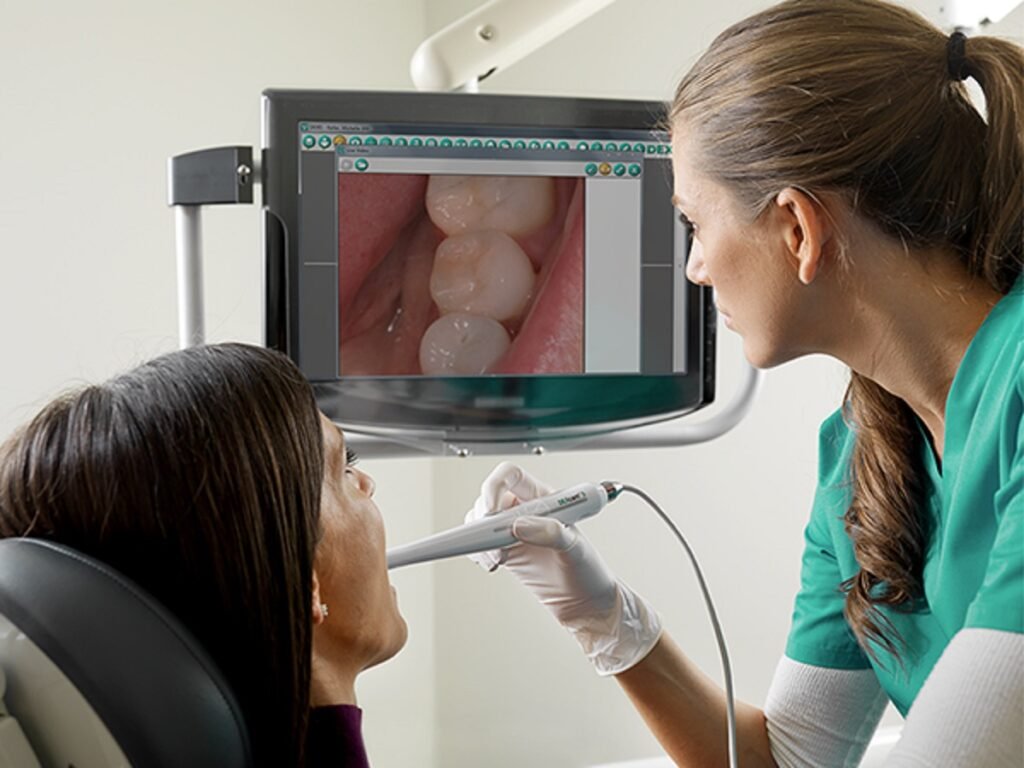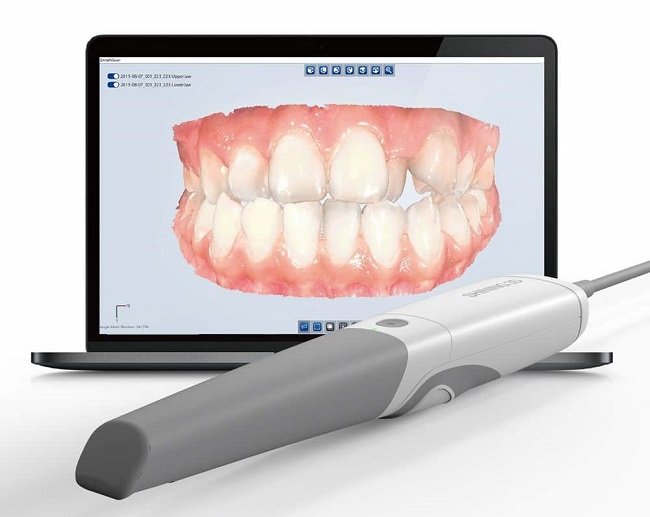In modern dentistry, intraoral imaging cameras have established themselves as a critical tool, providing the ability to enhance diagnostic accuracy and treatment planning. With high-definition intraoral camera systems consisting of high-resolution, clear images of the patient’s intraoral cavity to make identification of potential issues at an earlier stage and instantly share visual representation with your patient to explain the issues to them is a great addition. Aidite is one of the top manufacturers and suppliers of dental solutions, which step up your practice. They come with a lot of amazing features like high-definition intraoral cameras, LED lighting, and wireless intraoral cameras to make them more functional and easy to use than ever before.

What are Intraoral Imaging Cameras?
Intraoral imaging cameras are tiny, handheld, high-definition intraoral cameras that offer dentists a close-up view of teeth and gums to reach hard-to-see places. These cameras improve diagnostic precision and patient interaction through the aid of high-resolution imaging, LED lighting, and real-time feedback. Sharing images has also been made easy with features like USB dental cameras or wireless connectivity Intraoral cameras, but there is also another way to store images with patient records that can also increase the efficiency of a modern dental practice
Key Features of Intraoral Imaging Cameras
Dental intraoral cameras offer high-resolution clarity, LED illumination, real-time imaging, and seamless USB or wireless connectivity for precise diagnostics and effortless workflow.
1. Improved clarity with a high-resolution image:
High-definition intraoral cameras have high-definition sensors that take clear and close-up images of the mouth and help dentists find dental issues such as cavities, cracks, and plaque buildup. Such high resolution means improving our accuracy of diagnosis and informing us how best to approach treatment.
2. Optimal Illumination with LED Lighting:
LED lighting ensures that images are consistently bright and clear, even in difficult-to-reach areas of the mouth. It replaces the heat normally generated during conventional light sources with this modern technology, making it more comfortable for the patient while providing clear, precise visuals.
3. USB link-up for hassle-free connection:
With USB connectivity, portable dental imaging devices can easily connect to computers and other devices, facilitating quick storage, transfer, and sharing of images. The feature is beneficial for practices with electronic health records (EHR), enabling quicker documentation and diagnosis.
4. Get Real-Time Imaging Visual Feedback:
Real-time imaging allows for the immediate display of images on the screen as the camera is in use. The instant feedback allows dentists to make faster decisions and communicate with the patients by showing them precisely what the dentist sees and explaining the situation to them with clarity.
5. Increased Mobility with Wireless Connectivity:
Wireless intraoral cameras provide increased mobility, which means that the dentist can move around the treatment room freely without being tied down by wires. It also enables you to transfer images faster, find an easier place to mount the camera, and maintain a cleaner workspace with fewer cables.

Advantages of the use of Dental Intraoral cameras
High-definition intraoral cameras enhance diagnostics with clear, real-time images, improve patient understanding, streamline treatment planning, and boost efficiency—all while ensuring a comfortable experience.
1. Improved Diagnostic Accuracy:
With features like high-resolution imaging and real-time imaging, intraoral imaging cameras provide dentists with accurate and clear images, which improves diagnostic accuracy. This ensures the early detection of dental problems and, thus, more effective solutions.
2. Enhanced Patient Education:
By showing patients clear, high-quality images of their oral health, wireless intraoral cameras help patients better understand their conditions. Seeing images in real-time on a screen can increase awareness and trust in the proposed treatment plan.
3. Faster Planning for Treatment:
The USB dental cameras and wireless intraoral cameras make it easier to share images with co-workers or specialists for faster and better treatment planning. Such integration also strengthens intra-office collaboration among dental professionals, ensuring that patients receive the best care possible.
4. Improved Efficiency & Productivity:
The USB dental cameras allow for real-time visualization and wireless connectivity, making the diagnostic process less cumbersome. A dentist can simply take images, and thus, the total efficiency improves with more patients being treated in one day.
5. Comfortable for Patients:
Modern intraoral imaging cameras are small and feature LED lighting, providing a more comfortable experience for dental patients than traditional dental imaging methods. They are designed to be entirely free of discomfort so that they will be used during check-ups or more invasive treatments
What Are Intraoral Imaging Cameras Used For?
Portable dental imaging devices have become a staple in modern dentistry; their applications are ever-expanding and range from diagnostic, treatment planning, and patient communication aspects. They lend themselves
Routine Checkups
- Early Detection: Helps in identifying early signs of cavities, gum disease, plaque buildup, and other oral health issues before they become severe.
- Overlaid monitoring: By giving a transparent overview of the oral cavity, most steps have clear visualization for doctors and patients, allowing for prophylactic dental treatment.
- Prevention: It helps detect problems like those of cracks, lesions or enamel erosion that cannot be seen with normal examination.
Treatment Planning
- Precise Diagnosis: Clear images of the tooth and gum tissues allow for complex procedures such as fillings, crowns, and root canal treatment to be planned.
- Implant planning: Avoiding potential mistakes in placing the correct angle and size of the implant previously planned on 3D models. Greater awareness of the available bone structure and adjacent soft tissue.
- Fostering Tailor Made Treatment: This plays a vital role in framing tailor-made Dental Treatment plans by allowing dentists to determine the updated condition of the patients’ oral health closely.
Patient Education
- Visual Aspect: Provides real-time pictures of the patient’s oral cavity to understand why a specific dental treatment is required.
- Putting Patients in Control: When the problems are depicted visually, the patients are more likely to understand their oral health situation and adhere to the treatment instructions.
- Informed treatment options: The patients are able to visualize effects from either fillings, crowns, or extractions that lead to better treatment decisions.
Document Conditions for Insurance / Legal Purposes
- Correct Documentation: This gives you a documented visual history of a patient’s oral health, which is crucial for submitting insurance claims.
- Protection Against Possible Legal Issues: Documentations with pictures also serve as visual proof of what was there before the treatment. Thus, they provide protection for dentists if the patients ever claim that his/her teeth were damaged during the treatment.
- Better Archiving: Photographs can now be stored digitally and included in patient records to provide a visual history of the patient’s dental state over time.
Monitor Orthodontics or Post-surgery Progress
- Orthodontic Monitoring: Monitors progress on the orthodontic treatment to ensure whether progress or regression occurs through the treatment duration.
- Healing After Surgery: Help you monitor recovery so that you effectively recover from surgery, such as a surgery, implant, or gum surgery.
- Identification of Issues: Detects signs of infection, misalignment, or other complications during aligner use or healing from orthodontics or surgery to intervene as necessary.
Intraoral imaging cameras are a great aid in dentistry that help diagnose more accurately, work more efficiently, improve dentist-patient communication, and lead to precise treatment and better decision-making.

Why Intraoral Cameras are So Important in Dentistry
Intraoral imaging cameras offer high-resolution images that assist clinicians in making early detection and accurate diagnosis. Alongside these cameras, Aidite’s intraoral scanner further enhances digital diagnostics by capturing detailed 3D scans that support comprehensive treatment planning and streamline clinical workflows..
- High-Resolution Imaging: Allows for earlier diagnosis; enables treatment.
- Enhanced Patient Communication: The visuals make things easier for patients to understand their treatment.
- Seamless Documentation: Easy sharing of the patient data.
- Real-time Imaging: Gives you an instant feedback to make better decisions
- Connectivity: Reducing wires where it makes sense will aid workflow efficiency and show you care about patient comfort.
You can check Aidite’s intraoral scanner to experience how it can transform your practice with precision and efficiency.
FAQs
Q1. What is an intraoral imaging camera used for?
Dental intraoral cameras for dentists are great for acquiring high-resolution images of the teeth and surrounding structures, which can improve diagnostic accuracy, facilitate better identification of dental diseases, and help patients understand their oral conditions more intuitively
Q2. Are intraoral cameras better than the classic mirror?
For sure, the magnified detailed visuals and imaging in real-time on the screen, intraoral cameras increase diagnostic accuracy and patient understanding much better than traditional dental only the mirrors.
Q3. Can intraoral cameras help with insurance claims?
Yes, these cameras show a wealth of detail, and give dentists an opportunity to plan treatment, whether it be fillings, crowns, or implants, to make procedures more accurate and improve patient outcomes.
Conclusion
Dental intraoral cameras have changed the face of dentistry, providing increased accuracy and helping patients see and understand the treatment results before procedures start. These cameras, with features such as high-resolution imaging and wireless intraoral cameras, have turned into a basic tool for dentists. These also enable dentists to diagnose better and more accurately, show patients their oral health visually, and facilitate treatment planning. Incorporating USB dental cameras into their practices will help dentists build the patient experience, increase treatment effectiveness, and improve workflow. As a trusted provider of professional dental solutions, Aidite supports clinics with advanced technologies that empower modern dentistry. With ongoing innovations, intraoral imaging cameras will become increasingly indispensable, shaping the future of oral healthcare.



